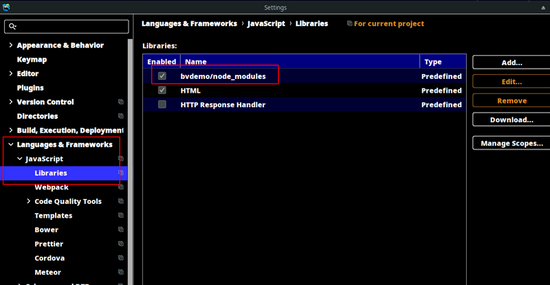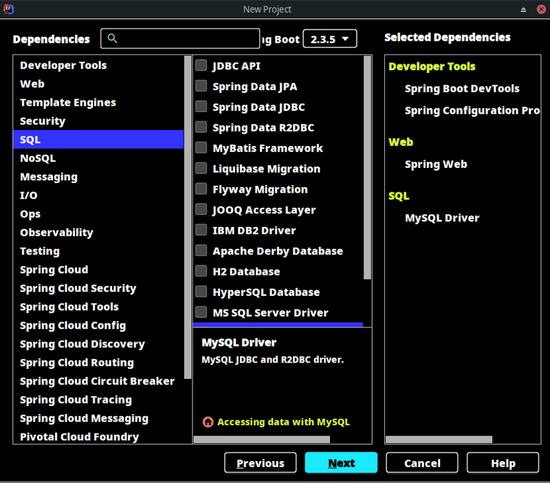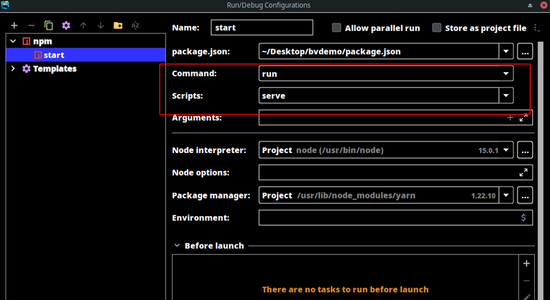您好,登录后才能下订单哦!
这篇文章给大家介绍在Vue项目中使用Spring Boot实现一个简单的用户登录功能,内容非常详细,感兴趣的小伙伴们可以参考借鉴,希望对大家能有所帮助。
1 概述
前后端分离的一个简单用户登录 Demo 。
2 技术栈
3 前端
3.1 创建工程
使用 vue-cli 创建,没安装的可以先安装:
sudo cnpm install -g vue @vue/cli
查看版本:
vue -V
出现版本就安装成功了。
创建初始工程:
vue create bvdemo
由于目前 Vue3 还没有发布正式版本,推荐使用 Vue2 :

等待一段时间构建好了之后会提示进行文件夹并直接运行:

cd bvdemo yarn serve
直接通过本地的 8080 端口即可访问:


3.2 依赖
进入项目文件夹:
cd bvdemo
安装依赖:
cnpm install bootstrap-vue axios jquery vue-router
应该会出现 popper.js 过期的警告,这是 bootstrap-vue 的原因,可以忽略:

依赖说明如下:
bootstrap-vue :一个结合了 Vue 与 Bootstrap 的前端 UI 框架axios 是一个简洁易用高效的 http 库,本项目使用其发送登录请求jquery :一个强大的 JS 库vue-router : Vue 的官方路由管理器3.3 开启补全
在正式编写代码之前开启对 bootstrap-vue 的补全支持,打开设置:

将项目路径下的 node_modules 添加到库中,把前面的勾给勾上,接着更新缓存并重启(`File->Invalidate Cache/Restart`)。
3.4 App.vue
去掉默认的 HelloWorld 组件,并修改 App.vue 如下:
<template>
<div id="app">
<router-view></router-view>
</div>
</template>
<script>
export default {
name: 'App',
}
</script>
<style>
#app {
font-family: Avenir, Helvetica, Arial, sans-serif;
-webkit-font-smoothing: antialiased;
-moz-osx-font-smoothing: grayscale;
text-align: center;
color: #2c3e50;
margin-top: 60px;
}
</style><router-view> 是一个 functional 组件,渲染路径匹配到的视图组件,这里使用 <router-view> 根据访问路径(路由)的不同显示(渲染)相应的组件。
3.5 新建 vue 组件
删除默认的 HelloWorld.vue ,新建 Index.vue 以及 Login.vue :

3.6 添加路由
在 main.js 同级目录下新建 router.js ,内容如下:
import Vue from "vue"
import VueRouter from "vue-router"
import Login from "@/components/Login"
import Index from "@/components/Index"
Vue.use(VueRouter)
const routes = [
{
path: '/',
component: Login,
props: true
},
{
path:'/index/:val',
name:'index',
component: Index,
props: true
}
]
const router = new VueRouter({
mode:'history',
routes:routes
})
export default routerroutes 表示路由,其中包含了两个路由,一个是 Login 组件的路由 / ,一个是 Index 组件的路由 /index/:val ,后者中的 :val 是占位符,用于传递参数。 router 表示路由器, mode 可以选择 hash 或 history :
hash 会使用 URL 的 hash 来模拟一个完整的 URL ,当 URL 改变时页面不会重新加载history 就是普通的正常 URLrouter 中的 routes 参数声明了对应的路由,最后要记得把 router 添加到 main.js 中。
3.7 vue.config.js
在 package.json 同级目录下创建 vue.config.js ,内容如下:
module.exports = {
chainWebpack: config => {
config.module
.rule('vue')
.use('vue-loader')
.loader('vue-loader')
.tap(options => {
options.transformAssetUrls = {
img: 'src',
image: 'xlink:href',
'b-img': 'src',
'b-img-lazy': ['src', 'blank-src'],
'b-card': 'img-src',
'b-card-img': 'src',
'b-card-img-lazy': ['src', 'blank-src'],
'b-carousel-slide': 'img-src',
'b-embed': 'src'
}
return options
})
}
}使用该配置文件主要是因为 <b-img> 的 src 属性不能正常读取图片,添加了该配置文件后即可按路径正常读取。
3.8 main.js
添加依赖以及路由:
import Vue from 'vue'
import App from './App.vue'
import {BootstrapVue, BootstrapVueIcons} from 'bootstrap-vue'
import router from "@/router";
import 'bootstrap/dist/css/bootstrap.css'
import 'bootstrap-vue/dist/bootstrap-vue.css'
Vue.use(BootstrapVue)
Vue.use(BootstrapVueIcons)
Vue.config.productionTip = false
new Vue({
render: h => h(App),
router
}).$mount('#app')引入 BootstrapVue ,并把路由注册到 Vue 实例中(就是倒数第2行,作为创建 Vue 实例的参数,注意这个很重要,不然路由功能不能正常使用)。
3.9 登录组件
也就是 Login.vue ,内容如下:
<template>
<div>
<b-img src="../assets/logo.png"></b-img>
<br>
<b-container>
<b-row>
<b-col offset="3" cols="6">
<b-input-group size="lg">
<b-input-group-text>用户名</b-input-group-text>
<b-form-input type="text" v-model="username"></b-form-input>
</b-input-group>
</b-col>
</b-row>
<br>
<b-row>
<b-col offset="3" cols="6">
<b-input-group size="lg">
<b-input-group-text>密码</b-input-group-text>
<b-form-input type="password" v-model="password"></b-form-input>
</b-input-group>
</b-col>
</b-row>
<br>
<b-row>
<b-col offset="3" cols="6">
<b-button variant="success" @click="login">
一键注册/登录
</b-button>
</b-col>
</b-row>
</b-container>
</div>
</template>
<script>
import axios from 'axios'
import router from "@/router"
export default {
name: "Login.vue",
data:function (){
return{
username:'',
password:''
}
},
methods:{
login:function(){
axios.post("http://localhost:8080/login",{
username:this.username,
password:this.password
}).then(function (res){
router.push({
name:"index",
params:{
val:res.data.code === 1
}
})
})
}
}
}
</script>
<style scoped>
</style>采用了网格系统布局 <b-row> + <b-col> ,其他组件就不说了,大部分组件官网都有说明(可以 戳这里 ),发送请求采用了 axios ,参数包装在请求体中,注意需要与后端( @RequestBody ,写在请求头请使用 @RequestParm )对应。
另外还需要注意的是跨域问题,这里的跨域问题交给后端处理:
@CrossOrigin(http://localhost:8081)
(本地测试中后端运行在 8080 端口,而前端运行在 8081 端口)
发送请求后使用路由进行跳转,携带的是 res.data.code 参数 ,其中 res.data 是响应中的数据,后面的 code 是后端自定义的数据,返回 1 表示注册成功,返回 2 表示登录成功。
3.10 首页组件
首页简单地显示了登录或注册成功:
<template>
<div>
<b-img src="../assets/logo.png"></b-img>
<b-container>
<b-row align-h="center">
<b-col>
<b-jumbotron header="注册成功" lead="欢迎" v-if="val"></b-jumbotron>
<b-jumbotron header="登录成功" lead="欢迎" v-else></b-jumbotron>
</b-col>
</b-row>
</b-container>
</div>
</template>
<script>
export default {
name: "Index.vue",
props:['val']
}
</script>
<style scoped>
</style>props 表示 val 是来自其他组件的参数,并将其作为在 v-if 中进行条件渲染的参数。
这样前端就做好了。下面开始介绍后端。
4 后端
4.1 创建工程
采用 Kotlin + Gradle + MyBatisPlus 构建,新建工程如下:



4.2 依赖
引入 MyBatis Plus 依赖即可:
implementation("com.baomidou:mybatis-plus-boot-starter:3.4.0")4.3 数据表
create database if not exists test; use test; drop table if exists user; create table user( id int auto_increment primary key , username varchar(30) default '', password varchar(30) default '' )
4.4 配置文件
数据库用户名+密码+ url :
spring: datasource: url: jdbc:mysql://localhost:3306/test username: root password: 123456
4.5 新建包
新建如下六个包,分别表示配置类、控制层、持久层、实体类、响应类、业务层。

4.6 实体类
package com.example.demo.entity class User(var username:String,var password:String)
4.7 持久层
package com.example.demo.dao
import com.baomidou.mybatisplus.core.mapper.BaseMapper
import com.example.demo.entity.User
import org.apache.ibatis.annotations.Mapper
import org.apache.ibatis.annotations.Select
@Mapper
interface DemoMapper :BaseMapper<User>{
@Select("select * from user where username=#{username} and password = #{password}")
fun selectByUsernameAndPassword(username:String,password:String):List<User>
}@Mapper 表示给 Mapper 接口生成一个实现类,并且不需要编写 xml 配置文件。 @Select 表示进行查询的 sql 语句。
4.8 响应体
package com.example.demo.response
class DemoResponse
{
var data = Any()
var code = 0
var message = ""
}package com.example.demo.response
class DemoResponseBuilder {
private var response = DemoResponse()
fun data(t:Any): DemoResponseBuilder
{
response.data = t
return this
}
fun code(t:Int): DemoResponseBuilder
{
response.code = t
return this
}
fun message(t:String): DemoResponseBuilder
{
response.message = t
return this
}
fun build() = response
}这里响应体分为:
与前端约定即可。生成响应体通过一个 Builder 类生成。
4.9 业务层
package com.example.demo.service
import com.demo.response.DemoResponse
import com.demo.response.DemoResponseBuilder
import com.example.demo.dao.DemoMapper
import com.example.demo.entity.User
import org.springframework.beans.factory.annotation.Autowired
import org.springframework.stereotype.Service
import org.springframework.transaction.annotation.Transactional
@Service
@Transactional
class DemoService
{
@Autowired
lateinit var mapper: DemoMapper
fun login(username:String, password:String): DemoResponse
{
val result = mapper.selectByUsernameAndPassword(username,password).size
if(result == 0)
mapper.insert(User(username,password))
return DemoResponseBuilder().code(if(result == 0) 1 else 2).message("").data(true).build()
}
}@Service 标记为业务层, @Transactional 表示添加了事务管理,持久层操作失败会进行回滚。 @Autowired 表示自动注入,在 Java
中可以使用直接使用 @Autowired ,而在 Kotlin 中需要使用 lateinit var 。
4.10 控制层
package com.example.demo.controller
import com.demo.response.DemoResponse
import com.example.demo.entity.User
import com.example.demo.service.DemoService
import org.springframework.beans.factory.annotation.Autowired
import org.springframework.web.bind.annotation.*
@RestController
@RequestMapping("/")
@CrossOrigin("http://localhost:8081")
class DemoController {
@Autowired
lateinit var service: DemoService
@PostMapping("login")
fun login(@RequestBody user: User):DemoResponse
{
return service.login(user.username, user.password)
}
}主要就是添加了一个跨域处理 @CrossOrigin ,开发时请对应上前端的端口。
4.11 配置类
package com.example.demo.config
import org.mybatis.spring.annotation.MapperScan
import org.springframework.context.annotation.Configuration
@Configuration
@MapperScan("com.example.demo.dao")
class MyBatisConfig@MapperScan 表示扫描对应包下的 @Mapper 。
4.12 测试
package com.example.demo
import com.example.demo.service.DemoService
import org.junit.jupiter.api.Test
import org.springframework.beans.factory.annotation.Autowired
import org.springframework.boot.test.context.SpringBootTest
@SpringBootTest
class DemoApplicationTests {
@Autowired
lateinit var service: DemoService
@Test
fun contextLoads() {
println(service.login("123", "456"))
}
}测试通过后后端就算完成了。
5 总测试
先运行后端, Kotlin 不像 Java ,生成工程时能自动配置了启动配置,需要手动运行启动类中的 main :

再运行前端:
npm run serve
不想用命令行的话可以使用图形界面配置一下:

根据控制台输出打开 localhost:8081 :


随便输入用户名与密码,不存在则创建,存在则登录:


注册的同时后端数据库会生成一条记录:

再次输入相同的用户名和密码会显示登录成功:

这样就正式完成了一个简单的前后端分离登录 Demo 。
关于在Vue项目中使用Spring Boot实现一个简单的用户登录功能就分享到这里了,希望以上内容可以对大家有一定的帮助,可以学到更多知识。如果觉得文章不错,可以把它分享出去让更多的人看到。
免责声明:本站发布的内容(图片、视频和文字)以原创、转载和分享为主,文章观点不代表本网站立场,如果涉及侵权请联系站长邮箱:is@yisu.com进行举报,并提供相关证据,一经查实,将立刻删除涉嫌侵权内容。